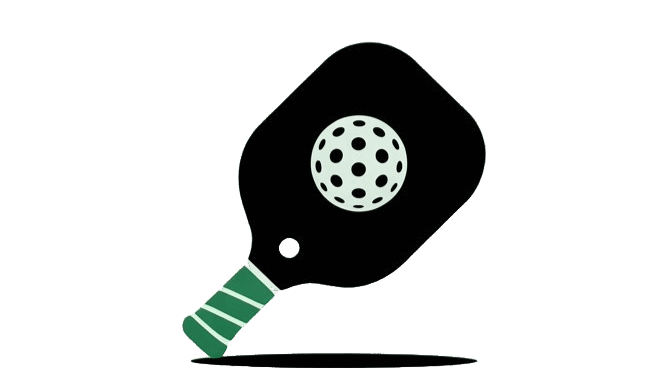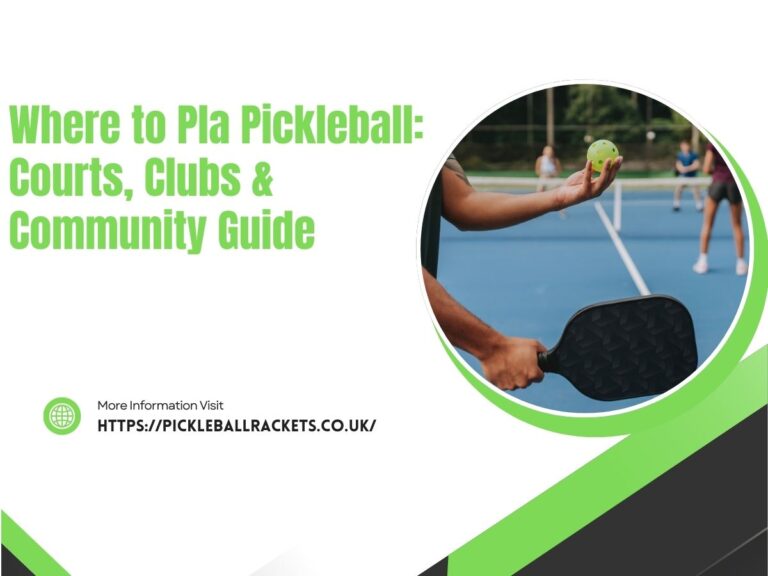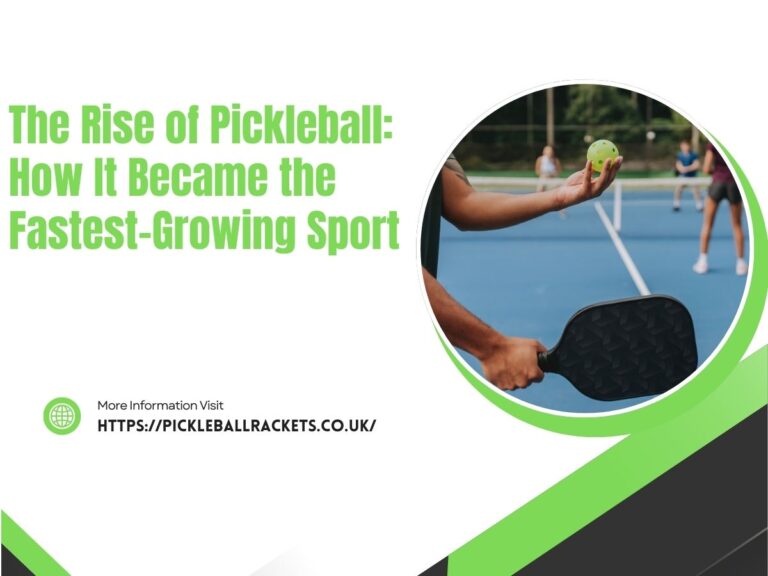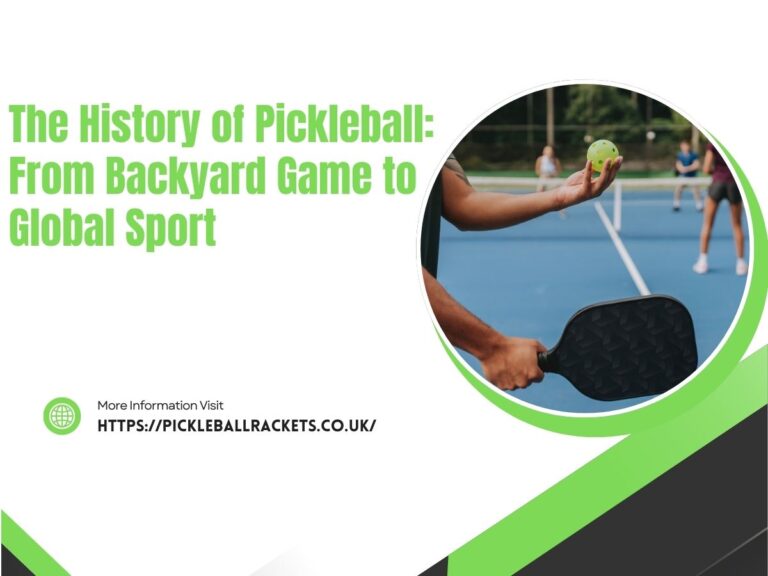Pickleball has taken the world by storm, offering a fun, social, and accessible sport for people of all ages and fitness levels. Its simple rules and smaller court size make it easy to learn, but as you progress, you’ll discover the significant impact that the right gear can have on your performance and enjoyment. Choosing the correct paddle, ball, and shoes can elevate your game, prevent injuries, and give you the confidence to dominate the court.
This ultimate pickleball equipment guide will walk you through everything you need to know. We will break down the essentials paddles, balls, and shoes to help you make informed decisions. Whether you’re a complete beginner buying your first setup or an experienced player looking to upgrade, this guide covers it all, with special considerations for players in the UK.
The Essential Pickleball Starter Kit
Before diving into the details, let’s cover the absolute must-haves for playing pickleball. The good news is, you don’t need a lot to get started.
- Pickleball Paddle: This is your primary tool. Unlike tennis racquets, pickleball paddles are solid, with no strings. They come in various materials, weights, and shapes, each affecting your play style.
- Pickleball Ball: A lightweight, perforated plastic ball. It’s crucial to use the right type of ball depending on whether you are playing indoors or outdoors.
- Appropriate Footwear: Court shoes are essential. The quick, lateral movements in pickleball require shoes that provide stability and support to prevent ankle sprains and other injuries.
- A Pickleball Court: You need a net and a court with the correct dimensions (44 feet long and 20 feet wide). Many tennis courts are being converted or dual-lined for pickleball use.
While other accessories like bags, grip tape, and eyewear are helpful, the three items above are the core components you need to begin your pickleball journey.
Pickleball Paddles: Your Key to Control and Power
Your paddle is the most critical piece of equipment you will purchase. It’s an extension of your arm and directly influences your ability to control the ball, generate power, and impart spin. Understanding the different components of a paddle is the first step to finding the perfect one for you.

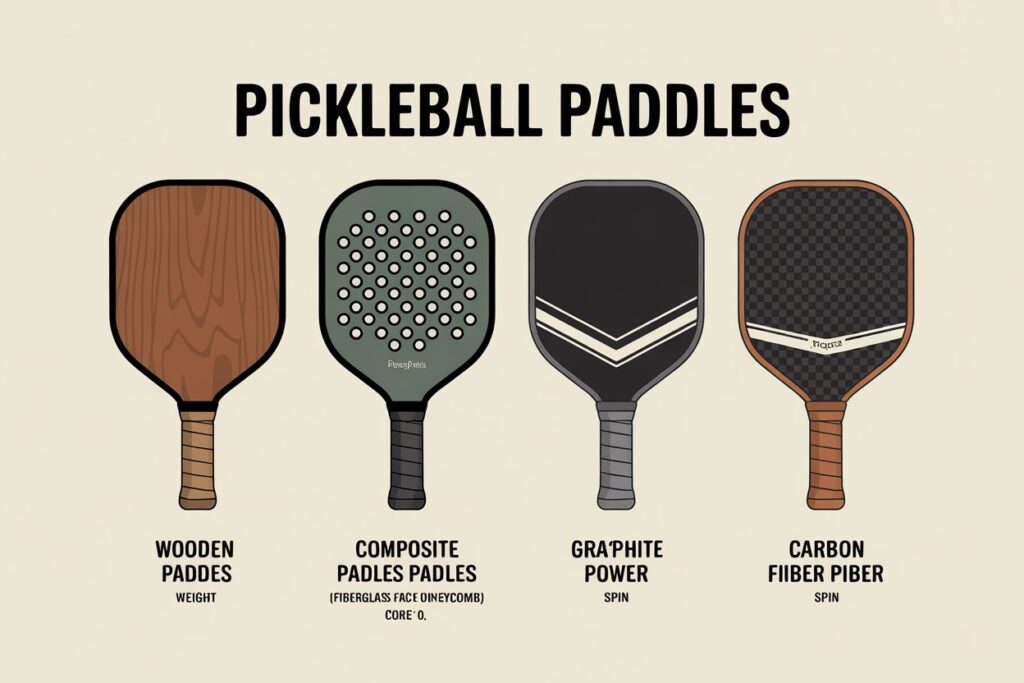
Pickleball Balls: Indoor vs. Outdoor Explained
You might think a ball is just a ball, but in pickleball, the difference between an indoor and outdoor ball is huge. Using the wrong one will negatively affect your game and the ball’s durability.
Key Differences: Indoor vs. Outdoor Balls
The primary distinction comes down to the plastic material and the hole pattern.
Outdoor Pickleball Balls
- Material: Made from a harder, more brittle plastic to withstand rough outdoor court surfaces (like asphalt or concrete) and wind.
- Holes: Feature around 40 smaller, drilled holes. This design helps the ball fly straighter in windy conditions.
- Performance: They are heavy, fast, and have a low, hard bounce. They come off the paddle quickly, favoring a harder-hitting, power-based game.
- Durability: Because of the hard plastic, they are prone to cracking, especially in cold weather. They also go “out-of-round” and lose their perfect shape with use, causing them to wobble in the air.
Indoor Pickleball Balls
- Material: Made from a softer, more flexible plastic compound. This is because indoor surfaces (like gym floors or polyurethane courts) are much smoother.
- Holes: Feature around 26 larger, molded holes. The larger holes make the ball fly slower through the air.
- Performance: They are lighter, slower, and have a higher, softer bounce. This results in longer rallies and rewards a softer, more controlled dinking game.
- Durability: The softer plastic is much less likely to crack. However, they will become soft and lose their bounce over time, feeling “mushy.”
Can you use an indoor ball outdoors? You can, but it’s not recommended. An indoor ball will be heavily affected by wind, and the rough outdoor surface will chew it up very quickly. Conversely, using a hard outdoor ball on a wooden gym floor can be loud and may result in unpredictable skids.

Which Balls Last Longer?
Durability depends on the environment. Indoor balls generally have a longer lifespan because they don’t crack as easily as outdoor balls. An indoor ball can last for many months of regular play before it becomes too soft.
Outdoor balls have a much shorter lifespan. A competitive player might crack several outdoor balls in a single match, especially in colder temperatures. It’s common for players to carry multiple new outdoor balls with them to every session.
Best Balls for Beginners vs. Competitive Play
For beginners, the choice of ball is less critical. The most important thing is to use the correct type for your court (indoor or outdoor). A slightly softer ball, like the Onix Fuse Indoor, can be beneficial for beginners playing indoors, as it’s a bit more forgiving. For outdoor play, the Franklin X-40 is a popular all-around choice that is used in many tournaments and is widely available.
For competitive play, players tend to prefer the balls they are most likely to encounter in tournaments.
- Popular Outdoor Balls: Dura Fast 40, Franklin X-40, and CORE Outdoor. The Dura is known for being very hard and fast, while the Franklin X-40 is slightly softer and more forgiving.
- Popular Indoor Balls: Onix Fuse G2 and Franklin X-26. Both are known for their consistent bounce and good durability on gym floors.
Buying Pickleball Balls in the UK: Brands like Franklin, Onix, and Head are readily available from UK-based online retailers and specialty sports shops. The Franklin X-40 is particularly easy to find and is a reliable choice for outdoor play in the UK.
Shoes for Pickleball: Your Foundation for Safety and Performance
The right footwear is non-negotiable in pickleball. The sport is defined by rapid, short-distance sprints and quick lateral side-to-side movements. Wearing the wrong shoes not only hinders your performance but also puts you at a high risk of ankle rolls, slips, and falls.
Why You Need Court Shoes
Running shoes are designed for one thing: forward motion. They have thick, soft cushioning in the heel to absorb impact and lack the structure needed for side-to-side stability. If you try to make a quick lateral cut in running shoes, your foot can slide over the edge of the sole, leading to a rolled ankle.
Court shoes, on the other hand, are specifically designed for sports like tennis, badminton, and pickleball. Their key features include:
- Lateral Support: A reinforced, more rigid structure on the sides of the shoe keeps your foot locked in place during lateral movements.
- Durable Outsole: The rubber on the bottom is designed to withstand the abrasive sliding and pivoting on a hard court.
- Lower Profile: Court shoes sit closer to the ground, providing a more stable base and lowering your center of gravity to prevent rollovers.
- Herringbone Tread: Most court shoes feature a herringbone (zigzag) pattern on the outsole, which provides excellent grip for multi-directional movement.

Are Tennis or Badminton Shoes Good for Pickleball?
Yes, absolutely. In fact, many shoes marketed as “pickleball shoes” are simply rebranded tennis shoes.
- Tennis Shoes: These are an excellent choice for pickleball, especially for outdoor play. They are built with robust lateral support and highly durable outsoles designed for the rigors of a tennis court. They often feature extra durability in the toe and medial side for players who drag their feet.
- Badminton/Volleyball Shoes: These are also a great option, particularly for indoor pickleball. They are typically lighter than tennis shoes and have gummy rubber outsoles that provide exceptional grip on wooden or polyurethane gym floors. They are designed for the same types of lateral movements and jumps found in pickleball.
Avoid: Running shoes, trail shoes, and casual sneakers. They do not provide the necessary support and can be dangerous to play in.
Indoor vs. Outdoor Pickleball Shoes
Just like with balls, the court surface dictates the best type of shoe.
Outdoor Pickleball Shoes
For outdoor courts (asphalt or concrete), you need a shoe with a highly durable outsole. A standard tennis shoe is the best option. The tough rubber compound is designed to handle the abrasive surface without wearing down too quickly. Look for shoes that advertise a “durable outsole” or come with an outsole warranty (a common feature for high-end tennis shoes).
Indoor Pickleball Shoes
For indoor courts (gym floors), your priority is grip. You need a shoe with a soft, “gummy” rubber outsole that won’t mark the floor. Volleyball or badminton shoes are perfect for this. Their outsoles are specifically designed to provide maximum traction on smooth, polished surfaces. While you can wear outdoor tennis shoes indoors, their harder rubber compound may not grip as well on a dusty gym floor.
Recommended Shoe Features for UK Players
When shopping for pickleball shoes in the UK, look for major tennis and court shoe brands like Asics, K-Swiss, Head, and Babolat. These are widely available.
- Lateral Support: Squeeze the sides of the shoe. A good court shoe will feel stiff and supportive, not flimsy like a running shoe.
- Cushioning: Look for a good balance. You want enough cushioning to absorb impact but not so much that you feel disconnected from the court.
- Weight: Lighter shoes will help you feel faster, but heavier shoes often provide more stability and durability. This is a personal preference.
- Fit: Your shoes should fit snugly without being restrictive. You should have about a thumb’s width of space between your longest toe and the end of the shoe.
Common Beginner Mistakes When Choosing Equipment
Navigating the world of pickleball gear can be tricky. Here are some common pitfalls to avoid.
Choosing a Paddle Based Only on Price or Looks: The cheapest wooden paddle will hold you back, while the most expensive pro-level paddle is overkill for a beginner. Don’t be swayed by cool graphics. Focus on the performance characteristics—weight, thickness, and material—that suit a beginner’s needs. Start with a quality mid-range composite paddle.
Ignoring Grip Size: Playing with the wrong grip size is uncomfortable and can lead to injuries like tennis elbow. Take the time to measure your grip or use the finger test to find a comfortable fit. Remember, you can always build up a smaller grip with an overgrip.
Using Running Shoes on the Court: This is the most dangerous equipment mistake you can make. The lack of lateral support in running shoes is a recipe for a sprained ankle. Invest in a proper pair of court shoes (tennis, badminton, or pickleball-specific) before you step on the court.
Playing Outdoors with Indoor Balls: You’ll spend your entire time watching the ball get pushed around by the wind, and it will be destroyed by the rough court surface in minutes. Always match your ball to your playing environment.
Also Read Pickleball vs Tennis, Padel & Paddle: Key Differences Explained?
Pickleball Equipment FAQs
How long does a pickleball paddle last?
A paddle’s lifespan is typically 1-3 years for a casual player and 6-12 months for a serious, competitive player. It depends on frequency of play and paddle quality. Look for signs of wear like a loss of surface texture, dead spots, or cracks.
Can you use tennis shoes for pickleball?
Yes, tennis shoes are an excellent choice for pickleball, especially for outdoor play. They provide the necessary lateral support and outsole durability required for the sport.
Do indoor balls work outdoors?
It is not recommended. Indoor balls are too light and soft for outdoor conditions. They will be significantly affected by wind and will wear out very quickly on an abrasive outdoor court surface.
What’s the difference between graphite and carbon fiber paddles?
Graphite paddles have a stiff, smooth face that provides excellent control and touch. Raw carbon fiber paddles have a naturally textured surface that grips the ball to generate significantly more spin. Carbon fiber is generally considered a more premium material offering superior all-around performance.
What is the best pickleball paddle for a beginner in the UK?
A great starting point for a UK-based beginner would be a midweight (7.5-8.2 oz) composite paddle with a 14mm or 16mm core. Brands like Head, Onix, and Zcebra offer excellent beginner-to-intermediate paddles that are readily available in the UK and provide a good balance of power, control, and forgiveness.
Conclusion: Gearing Up for Success
Getting started in pickleball is easy, and investing in the right equipment from the beginning will set you up for a safer, more enjoyable experience on the court. You don’t need to break the bank, but making smart choices will accelerate your learning curve and help you play your best.
To recap:
- Paddle: Start with a midweight (7.5-8.2 oz), 16mm thick composite paddle. It’s the most versatile and forgiving option as you develop your skills.
- Balls: Always use outdoor balls for outdoor courts and indoor balls for indoor courts. The Franklin X-40 is a reliable and widely available choice for UK outdoor play.
- Shoes: This is a matter of safety. Ditch the running shoes and invest in a pair of court shoes (tennis or badminton shoes work perfectly) to protect your ankles and improve your movement.
By avoiding common beginner mistakes and choosing gear that fits your needs and budget, you’ll be well on your way to discovering why pickleball is the fastest-growing sport in the world. Now, get out there and have fun.
